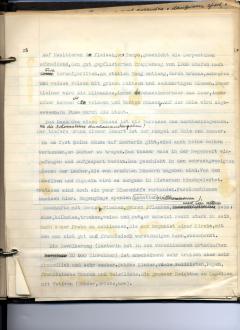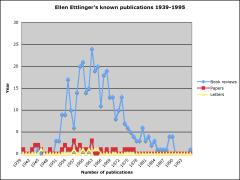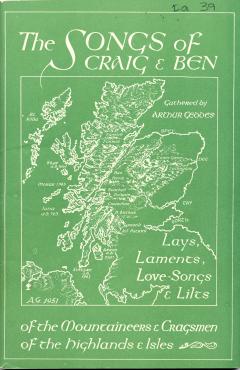ENGLAND: THE OTHER WITHIN
Analysing the English Collections at the Pitt Rivers Museum
Ellen Ettlinger - Biography
Alison Petch,
Researcher 'The Other Within' project
Relatively little is known about Ellen Ettlinger's life. Only one obituary can be found for her, that published in 1995 in Folklore.
Early life
She was born in 1902 as Ellen Rathenau. It is clear from the Folklore obituary that she came from the famous family of Rathenau who founded AEG, the massive engineering company in Germany. It seems likely that her paternal grandfather was Moses (also known as Moritz) Rathenau (1800-1871) who was a grain merchant in Berlin. He married Therese Liebermann. Her uncle was Emil Rathenau (1838-1915) who founded AEG, an electrical-engineering company and was married to Mathilde Nachmann. One of their sons, Walther Rathenau was a very famous German politician, mentioned in Folklore as 'her oldest cousin'. He was Foreign Minister of Germany in 1922 when he was assassinated by right wing plotters, a huge scandal in Germany. Emil apparently had another son, Erich (1871-1903) who might have been Ellen's father. She had a brother, Henry T. Rathenau of Berlin, who co-owned a famous painting with her. It is clear from all this that Ellen did indeed come from 'a Jewish family highly distinguished in German history and politics' as her obituary puts in. The image is of one of her diaries, an account of a Mediterranean cruise.
Early adulthood in Germany
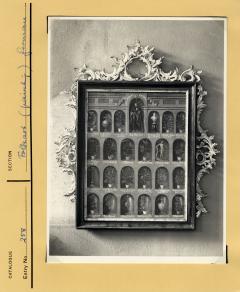
1965.5.1. 246 Image of picture in Germanisches Museum, Nuremberg. Dated 1938, the year Ettlinger left Germany
Her first journal also records the births of her two children, her daughter Eleonore [Eleanor] Marie who was born on 2 April 1925 and her son Ello Georg[e] who was born 5 May 1927. Ello's unusual first name was formed from his parents' first names, Ellen and Lionel. 'Eleonore Ettlinger' wrote to the British Medical Journal on October 26 1963 about the problems of employment for married female doctors (she mentions that she has four children, so she was using her maiden name). Ellen's son became the neuropsychologist George Ettlinger, who worked for the University of London and was an experimental scientist. He was a father of comparative neuropsychology and died in 1993, for more information go here.
The journals also frequently mention an Ernst (Onkel Ernst), the Ernst Rathenau mentioned here, an art publisher who worked for Euphorion Verlag and Ernst Rathenau Verlag until 1933 when he was forced to close. He had lived at Berlin-Charlottenburg. He emigrated to the USA in 1938, after 1945 he returned frequently to Germany and died there in 1986. Ellen is said to have co-owned a picture, The view of the Keizersgracht and Westerkerk in Amsterdam by Jan van der Heyden which was on loan to the Metropolitan Museum of Art in New York until the early 1990s with her brother Ernst.
The image shows one of Ettlinger's working catalogue cards, this image was filed under Folkart. It shows an image of 'Christ as the Good Apothecary'. It may be coincidence that this image dates from the time that Ettlinger was still in Germany, but she may also have taken the photograph herself before she became a refugee.
Life in England after 1938
The obituary says that 'Ellen, with her two young children, took refuge for some years [from Nazi persecution] in a remote part of Bavaria'. Life in Germany became untenable and Ellen left with her two young children. She arrived in Oxford as a refugee in 1938. As soon as war broke out she was classified as an "enemy alien", as were all the German refugees. As the obituary makes clear, '[w]ith huge determination she mastered English, acquired domestic skills, worked for the Red Cross'. She presumably had previously always had support from servants, so her life in the UK must have been very different from that in Germany.
In September 1939, upon the outbreak of war, the UK instituted action against enemy aliens like Ettlinger. All Germans, Austrians and Italians over the age of 16 were called to special tribunals and the risk they posed assessed as either high, doubtful or no security risk. Many Jewish refugees were classified in the 'no risk' category. Internment camps were established and male 'enemy aliens' were transferred. By 1941 attitudes had changed and a more lenient approach was taken. It is clear that Ettlinger must have been identified as no security risk because she continued to live in Oxford from this date until her death in 1994.
Interest in folklore

1965.5.1.460 Amulets (horse-shoe and rodent feet) on door of house in Lake District, photographed by Ernest G. Rathenau c. 1950
The image shows an example of one of the photographs from her collection, it was taken by her brother Ernst. The chart shows Ellen Ettlinger's publications between 1939 and her death, her production of book reviews peaked in the 1960s.
Oxfordshire and District Folklore Society
She was instrumental in settling up an Oxford branch of the Folklore Society with Christina Hole and Beatrice Blackwood (who worked at the Pitt Rivers Museum). At a meeting of the Council of the Folklore Society in 2 June 1948 a resolution was passed to establish an ‘Oxfordshire and District Branch of the Folklore Society’. ‘Its objects shall be to collect, record and study the folklore of Oxfordshire, and the neighbouring counties, and to further the study of the international folklore of these districts.’ (BB uncatalogued correspondence and memories of BB, folder ‘The Folklore Society 1948-49, agenda for the meeting). The Oxfordshire Branch was set up partly because of the difficulty of getting into London for Society meetings, partly to enable courses of lectures in the winter outside normal meeting times, and partly to help collect material in Oxfordshire and neighbouring counties. They hoped to recruit from villages throughout Oxford, and proposed to supply lecturers for local Women’s Institutes.
Ettlinger was obviously a key member of the Society. Possibly from the outset [1], she was the Vice-Chairman of the Society (as it was termed). It is unclear what her duties were but she obviously contributed to the seasons of talks. In the summer season of lectures of 1950 she stood in when Barbara Aitken (also known as Barbara Freire-Marreco), the programmed speaker, was ill:
'Mrs Ettlinger, Vice-Chairman of the Society, kindly took [Aitken's] place at short notice and spoke on Folk-Life in the Aran Isles. She showed some fifty slides from photographs taken by herself and others. Her paper, which described many aspects of the islanders life and customs, will shortly be published in the Roman folklore journal, Lares.' [Annual record no. 3, October 1951, p.7]
Ettlinger spoke again on June 6 1952, this time on 'Folklore of Stones, Wells and the Sea in Brittany and Ireland'. The [Annual Record relates that she discussed sacred stones, trees and holy wells in these countries. In the second half of her talk she concentrated on Celtic folklore about the land and sea, this part she said was going to be published in the journal, Folklore. This appears to be the article, 'A Breton Tradition', published in Folklore, Vol. 63, No. 4 (Dec., 1952), pp. 231-236.
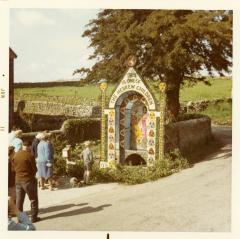
1998.464.8 Dressed Yew Tree Well Tissington 1971 Photographer: Ingegard Vallin, donated by Ellen Ettlinger
From the Annual Record no. 5 published in October 1953 until number 14 published in 1962, Ettlinger published (in ten parts) her 'Monuments of Folklore in Oxfordshire'. These formed a substantial majority of each of the issues, comprising at least 4 pages and frequently 6. This dominance was explained in October 1953 as follows:
'As this first guide for folklorists is bound to have many shortcomings, the Editor [Christina Hole] has agreed to publish additions in future numbers of the Annual Record.' [Annual Record no. 5, October 1953: p.4]
These articles are similar in content to that published in 1962 by her as 'Folklore in Oxfordshire Churches', Folklore, Vol. 73, No. 3 (Autumn, 1962), pp. 160-177.
Ettlinger appears to have given her final paper to the Society on 6 June 1962. This was the paper which was later published in Folklore (details above):
As readers of the Annual Record will know, she has devoted a great deal of time and energy to the collection of folklore connected with the churches in the county, and in her lecture she provided a wealth of traditional and archaeological detail, much of it unfamiliar even to people living in the parishes concerned.
[Annual Record no. 14, 1962: p. 2]
It appears that by 1963 her formal involvement with the Society had ended. The Society itself appears to have disappeared in 1965.[2]
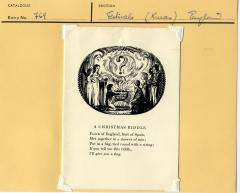
1965.5.1 237 One of Ettlinger's working catalogue cards showing a Xmas card to her from Peter & Iona Opie
Oxford University Anthropology Society
Ettlinger made other contributions to intellectual life in Oxford. On 2 November 1939 she gave a talk to the Oxford University Anthropology Society meeting on 'Documents of British superstition in Oxford' 'In this she described and classified the many objects preserved in Oxford colleges and museums to which amuletic properties had been ascribed in the past or which had been used as charms for good or evil, from medieval times to as recently as the last war' (this is obviously based on similar material to her 1943 publication). On 28 November 1946 she gave another paper on "Precognitive dreams in Celtic Legend", this was published in Folklore, Vol. 59, No. 3 (Sep., 1948), pp. 97-117. She appears to have been a member of this society. She was also a member of the Royal Anthropological Institute.
Ettlinger's donations
Ettlinger donated some of her working materials to the Pitt Rivers Museum including a photographic card catalogue system, and also a large number of pamphlets to the Balfour Library, at the Museum.Find out more about her donations
Final years
In her last years she suffered from ill-health and was no longer able to attend Folklore Society meetings in London. Ellen Ettlinger died in 1994 at the age of ninety-two, her final book review appeared in the same edition of Folklore as her obituary, which is a fitting tribute to her committment to the subject.
Acknowledgements
Thanks to the internet I managed to contact two descendants of Ellen Ettlinger. My thanks to Anthony Ettlinger, Ellen's grandson, who kindly provided the name of his grandfather and the explanation for his father's unusual first name. Many thanks also to David Herman, another of Ellen's grandchildren, who provided more details about Lionel Ettlinger, Ernst Rathenau and his mother Eleanor Marie Herman. Finally my gratitude to Elin Bornemann for her help in preparing this biography and also translating so many scraps of German.
Sources:
The journals of Ellen Ettlinger, PRM manuscript collections Ettlinger Boxes 1 and 2
Anthony Ettlinger
David Herman
Simpson, Jacqueline. 1995 'Ellen Ettlinger, 1902-1994' Folklore vol. 106 (1995), p.86
http://de.wikipedia.org/wiki/Moritz_Rathenau
http://de.wikipedia.org/wiki/Emil_Rathenau
http://en.wikipedia.org/wiki/Emil_Rathenau
http://en.wikipedia.org/wiki/Walther_Rathenau
http://www.archive.org/stream/walterrathenauhi006716mbp/walterrathenauhi006716mbp_djvu.txt
http://www.nga.gov/exhibitions/2000/dou/paint3info.shtm [Henry Rathenau]
http://www.nationalarchives.gov.uk/releases/2007/march/policy.htm
http://www.bbc.co.uk/ww2peopleswar/timeline/factfiles/nonflash/a6651858.shtml?sectionId=1&articleId=6651858
http://www.kettererkunst.com/detailse.php?obnr=410702766&anummer=315
http://www.sciencedirect.com/science?_ob=ArticleURL&_udi=B6T0V3WS61HNG&_user=126524&_rdoc=1&_fmt=&_orig=search&_sort=d&view=c&_version=1&_urlVersion=0&_userid=126524&md5=312968f41b54c7c41e247bb797fe7875
Notes
[1] The first Annual Record is missing from the copies held in the Oxfordshire Studies Centre where they were consulted, in addition the Society appears to have been first established in 1948, but the first annual report not published until 1950. A copy of the first record is available from the Sackler Library.
[2] The last copy of the Annual Record of the Oxfordshire and District Folklore Society in the records of the Oxfordshire Studies Centre is dated 1965. That annual report repeats 'a reminder' about what the society was set up to do, BUT it appears to mark the end of the formal recording at least of its activities.
